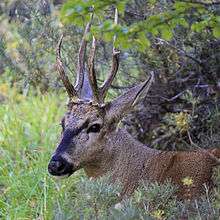South Andean deer
| South Andean deer | |
|---|---|
 | |
| Scientific classification | |
| Kingdom: | Animalia |
| Phylum: | Chordata |
| Class: | Mammalia |
| Order: | Artiodactyla |
| Suborder: | Ruminantia |
| Family: | Cervidae |
| Genus: | Hippocamelus |
| Species: | H. bisulcus |
| Binomial name | |
| Hippocamelus bisulcus Molina, 1782 | |
 | |
| Geographic range | |
The south Andean deer (Hippocamelus bisulcus), also known as the Chilean guemal or huemul (/ˈweɪmuːl/ WAY-mool, Spanish: [weˈmul]), is an endangered species of deer native to the mountains of Argentina and Chile. One of two mid-sized deer of the Hippocamelus genus, the south Andean deer ranges across the high mountainsides and cold valleys of the Andes. The distribution and habitat, behaviour, and diet of the deer have all been the subject of study. The viability of the small remaining population is an outstanding concern to researchers.
The huemul is part of Chile's National Coat of Arms and it is since 2006 a National Natural Monument.
Description

The south Andean deer is well-adapted to broken, difficult terrain with a stocky build and short legs. A brown to greyish-brown coat tapers to white undersides and a white marked throat; the long, curled hairs of the coat provide protection against cold and moisture. Does are 70 to 80 kg. (154-176 lbs.) and stand 80 cm. (31 in.), while bucks are 90 kg (198 lbs.) and 90 cm (35 in).[2] (Other weight suggestions are lower.)[3] There is no sexual size difference amongst fawns, which are born unspotted.[2]
Sexual dimorphism is notable. Only the bucks have antlers, which are shed each year toward the end of winter. Males also have a distinctive black "face mask", which curves into an elongated heart-shape surrounding a forehead of the principal brown colour.[2] Unusually for a dimorphic ungulate, research has shown south Andean deer will congregate in mixed-sex groups, and the length of time spent inter-mixing increases with group size. The farther the animals are from rocky slopes the larger the size of observed groups, suggesting predation rates are lowest on slopes and greatest in open areas such as valley bottoms.[4]
Distribution and habitat

The animal ranges across a variety of often difficult habitat. Open periglacial scrubland, low bluffs and other rocky areas, and upland forests and forest-border are principal range types.[2] One study of coastal fjord populations found males and juveniles preferred periglacial grassland; females were mainly found on bluffs, and fawns exclusively so. Gunnera plants were a principal dietary item.[5]
While previously found over much of southwestern South America, the current status of the south Andean deer is critical. Numbers in Argentina were estimated at 350–600, in fragmented groups, as of 2005.[6] Argentinian national authorities have been criticized for calling the species' situation satisfactory, where research shows declining numbers; further research on habitat viability and conservation centers have been urged.[6]
Pressures on Huemul populations include economic activities and invasive species. One study in Argentina's Nahuel Huapi National Park found thirty-two plant items in its diet. The most common of these, the Lenga beech, was also a primary food item of the red deer, causing displacement to marginal areas and increased vulnerability for the smaller South Andean Deer.[7] Both decreased reproduction rates and increased morbidity may be affecting the population in Argentina; predation by the Cougar, the South Andean Deer's only natural predator, remains a principal cause of mortality in Argentina.[8]
Conservation
According to the International Union for the Conservation of Nature (IUCN), the species’ original global population is estimated to have suffered reductions of 99 per cent in size and more than 50 per cent in distribution range. Therefore, the species is listed as “Endangered” on the IUCN Red List.[9] Habitat fragmentation and poaching remain the main threats to the species.
Under the auspices of the Convention on Migratory Species of Wild Animals (CMS) (the Bonn Convention), a Memorandum of Understanding (MoU) on the Conservation of the huemul was concluded between Argentina and Chile, and came into effect on 4 December 2010. The MoU aims to improve the conservation status of the species by close cooperation between the two range States, since the species migrate across the border region of these countries.
References
- ↑ Jiménez, J., Guineo, G., Corti, P, Smith, J.A., Flueck, W., Vila, A., Gizejewski, Z., Gill, R., McShea, B. & Geist, V. (2008). Hippocamelus bisulcus. In: IUCN 2008. IUCN Red List of Threatened Species. Retrieved 10 April 2009. Database entry includes a brief justification of why this species is of endangered.
- 1 2 3 4 Van Winden, Jasper. Diet and habitat of the huemul (Hippocamelus bisulcus) in Bernardo O’ Higgins National Park, Chile (2006). THESIS, Department of Science, Technology and Society, University of Utrecht. (PDF)Retrieved on: 2007-06-07
- ↑ Walker, Mark (2005). "South Andean Deer Hippocamelus bisulcus". World Deer. Biology Department, Siegen University. Retrieved 2007-06-07.
- ↑ Frid, Alejandro (1999). "Huemul (Hippocamelus bisulcus) sociality at a periglacial site: sexual aggregation and habitat effects on group size". Canadian Journal of Zoology 77 (7): 1083–1091. doi:10.1139/cjz-77-7-1083. Retrieved 2007-06-06.
- ↑ Frid, A. (1994). "Observations on habitat use and social organization of a huemul Hippocamelus bisulcus coastal population in Chile". Biological Conservation 67 (1): 13–19. doi:10.1016/0006-3207(94)90003-5. Retrieved 2007-06-07.
- 1 2 Flueck, W.T.; J. M. Smith-Flueck (June 2005). "Predicaments of endangered huemul deer, Hippocamelus bisulcus, in Argentina: a review". European Journal of Wildlife Research 52 (2): 69–80. doi:10.1007/s10344-005-0020-4. Retrieved 2007-06-06.
- ↑ Gladys, Galende; Ramilo, Eduardo; Beati, Alejandro (April 2005). "Diet of Huemul deer ( Hippocamelus bisulcus ) in Nahuel Huapi National Park, Argentina". Studies on Neotropical Fauna and Environment 40 (1): 1–5. doi:10.1080/01650520400000822. Retrieved 2007-06-07. Cite uses deprecated parameter
|coauthors=(help) - ↑ Smith-Flueck, Jo Anne M.; W. T. Flueck (September 2001). "Natural mortality patterns in a population of southern argentina huemul(Hippocamelus bisulcus), an endangered andean cervid". Zeitschrift für Jagdwissenschaft 47 (3): 178–188. doi:10.1007/BF02241548. Retrieved 2007-06-07.
- ↑ South Andean Huemul IUCN Red List: http://www.iucnredlist.org/details/10054/0
